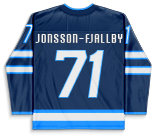
NHL Hockey Player News

Ruzicka made his Coyotes debut on February 12th and has played three games with the team since being claimed on waivers from the Calgary Flames earlier this month. In 42 games this season, the Slovak-born Ruzicka has nine points (3G / 6A). He is expected to have his contract terminated upon clearing waivers.

Barre-Boulet has been a healthy scratch most of the season for Tampa Bay but suddenly played in four of the last seven games. In his last outing, Barre-Boulet played 7:42 time-on-ice, recording one shot and three hits.

In seven games with Montreal, Gignac has one point (1G / 0A), six shots, and seven hits. Most of his 2023-24 campaign has been spent with the Laval Rocket of the AHL, where he has been extremely productive, scoring 42 points (14G / 28A) in 43 games.

White was with Pittsburgh since the beginning of January but was placed on waivers by the team on Wednesday before being claimed by Montreal. White played 11 games with Pittsburgh this season and failed to register a point.

White has been with Pittsburgh since the beginning of January but has been placed on waivers with the intention of being reassigned to Wilkes-Barre/Scranton Penguins (AHL). White played 11 games with Pittsburgh this season and failed to register a point.

Sanford was a healthy scratch in Monday's matchup against the Carolina Hurricanes and was placed on waivers by the Blackhawks on Tuesday. In 26 games this season, the 29-year-old Sanford has five assists, 19 hits, and 17 blocks.

MacDonald made his return to the Sharks lineup on Monday after being a healthy scratch in his previous outing but was placed on waivers by the Sharks on Tuesday. In 22 games this season, MacDonald has seven points (6G / 1A), 34 shots, and 33 hits.

Matthew Phillips had predominantly been an AHL player but spent most of the 2023-24 campaign with the Washington Capitals before being placed on waivers on Thursday. In 27 games with the club, he registered five points (1G / 4A) while averaging 10:16 time-on-ice.

Matthew Phillips had predominantly been an AHL player but has spent most of the 2023-24 campaign with the Capitals. In 27 games with the club, he registered five points (1G / 4A) while averaging 10:16 time-on-ice.

Kallionkieli was the 5th-round pick of the Golden Knights in the 2019 NHL Entry Draft. The 22-year-old Finn has yet to play an NHL game and has spent part of this season playing overseas.

Pitlick has regularly been a healthy scratch the last couple of weeks, playing only one of the last five games for the Blackhawks. In nine games this season, Pitlick has zero points, 13 shots, and nine hits while averaging 15:35 time-on-ice.

Philp had the potential to make the Blackhawks' opening night roster but was placed on the injured reserve after undergoing Achilles surgery in the offseason. The 27-year-old forward appeared in three games for Chicago in 2022-23 and picked up an assist and two PIMs. He played the majority of last season in Rockford, where he had 29 goals, 53 points and a +17 plus/minus in 60 games played.

After playing five straight for the Rangers, Pitlick was a healthy scratch on Monday before being placed on waivers on Tuesday. Adam Edstrom replaced Pitlick in the lineup on Monday. In 34 games this season, Pitlick has four points (1G / 3A) while averaging 10:12 time-on-ice.

Stevens and the Red Wings have agreed to mutually part ways which has led to the 27-year-old to clear waivers and have his contract terminated. The center was a fifth-round pick in the 2016 NHL Draft (125th) by the St. Louis Blues and had 11 points (3G/8A) in 31 games played with Grand Rapids (AHL) this season.

MacEwen has been a healthy scratch for five straight games, last playing on January 23rd, and has been placed on waivers. The hard-nosed forward has three points (2G / 1A) and 38 hits while averaging 6:23 time-on-ice through 22 games this season.

Willman has not played the last two games for the Devils and has been placed on waivers, likely to make space to recall a netminder in response to Vitek Vanecek dealing with an injury. The 28-year-old Willman has two points (1G / 1A) in 13 games with the Devils this season.

Gawanke has spent the entirety of the season with the San Jose Baracuda of the AHL, tallying 27 points (8G / 19A) in 38 games. The 24-year-old was the fifth-round pick of the Winnipeg Jets in the 2017 NHL Entry Draft. He will return to Germany and will play for Adler Mannheim.

The 35-year-old Bonino was averaging 12:15 time-on-ice this season and had been held off the scoresheet in 14 straight games. Assuming he goes unclaimed, the veteran forward will be a free agent after his contract is terminated by the Rangers.

With newcomer Sean Monahan joining the Jets and Mark Scheifele being activated from IR, Jonsson-Fjallby has been placed on waivers. In 26 games this season, the 25-year-old Jonsson-Fjallby has five points (2G / 3A), 23 shots, and 28 hits while averaging 8:07 time-on-ice.
